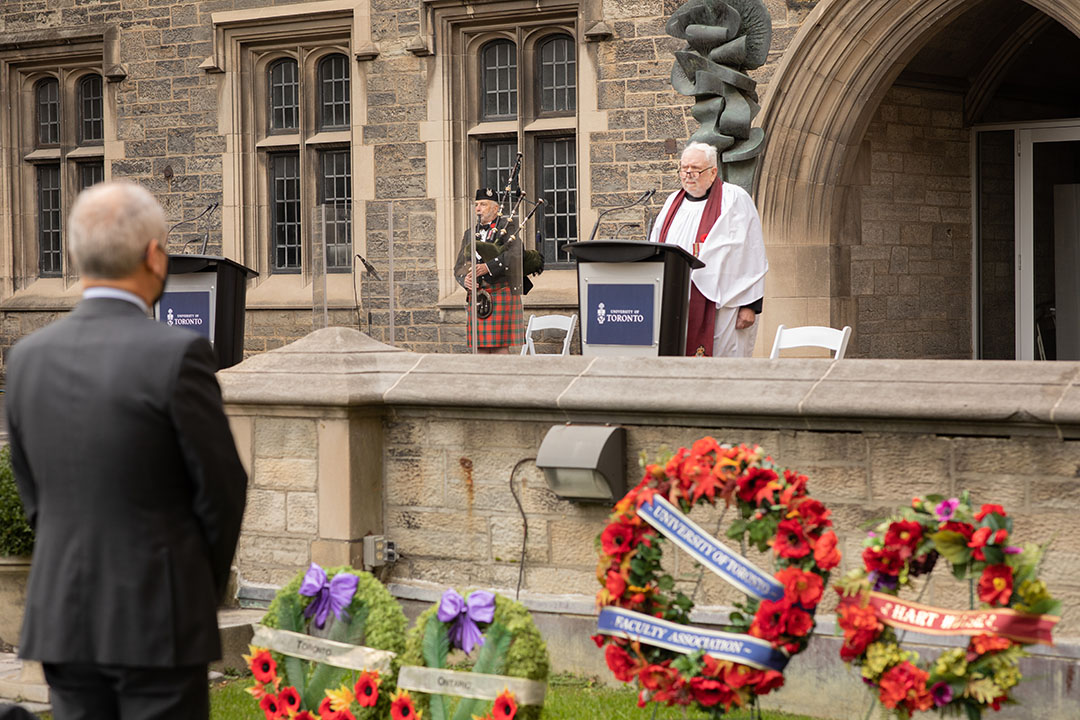U of T held its annual Remembrance Day Service on November 11, paying tribute to U of T community members who served during World War I. Observing Remembrance Day is a tradition in many Commonwealth countries to mark the day that the first World War ended.
U of T’s ceremony had very limited in-person attendance, and required physical distancing due to COVID-19. The ceremony was also livestreamed for those who could not attend in person.
This is the second year in a row that the service has been affected by the pandemic. Last year, the service was made up of pre-recorded performances and livestreamed for community members to view.
The service traditionally takes place at Soldiers’ Tower, which was built in 1924 to commemorate the people who lost their lives in World War I. This year’s event was moved to an alternative location near Hart House due to the ongoing construction in the King’s College Circle area — part of the Landmark Project — which meant that holding the event at Soldiers’ Tower was not possible. Daniel Hendrickson, chair of the Soldiers’ Tower Committee, said Hart House’s historically central role in student life has made the location an appropriate one for the ceremony.
“Many of the first students to use Hart House were veterans who had seen their colleagues perish in the Great War, and many that followed fought and died in the Second World War,” said Hendrickson in his opening speech. “Their legacies remind us that it was a World War for the university.”
“They expected a war where bravery would win the day, and we found a war where endurance in the face of killing on an industrial scale would at best hold the line,” said Chaplain Richard Ruggle in his speech. “As losses mounted, The Varsity would publish photos of the casualties with a brief note: they were from this town, from this family, they went to this school, this is what they were studying preparing for their future, they are no longer with us.”
This year marked the 20-year anniversary of 9/11 and the end of the war in Afghanistan that followed the attack, which resulted in the perpetuation of terrorism in the region and a humanitarian crisis. Chaplain Ruggle, who officiated the service, paid special tribute to Canadians who sacrificed their lives in the Afghanistan mission.
“We are connected today as we commemorate men and women from your family, your university, your town, your regiment,” said Chaplain Ruggle. “For some, Afghanistan is as remote as the First World War over a century ago… For others, it’s very real, as they continue to deal with the physical and spiritual challenges.”
Canadian Armed Forces were deployed in Afghanistan for 13 years. More than 40,000 Canadian soldiers served in the country during that time and 158 soldiers were killed. Thousands of veterans continue to suffer physically and psychologically after their mission ended, which has resulted in additional deaths.
Members representing the university, alums, faculty, students, the Canadian Armed Forces, and other institutions and organizations came forward during the ceremony to place wreaths on the walls of Hart House. The colleges, faculties, departments, programs, student societies, fraternities, and sororities who were not able to send representatives in person sent virtual messages of support.
The service culminated in a moment of silence. “When the ceasefire took place in November 1918, the soldiers were surprised by the silence. The guns that threaten them constantly were silent,” said Chaplain Ruggle. “That silence and memory of the fallen has quickly become the defining moment of our service. It can speak when words fail.”


